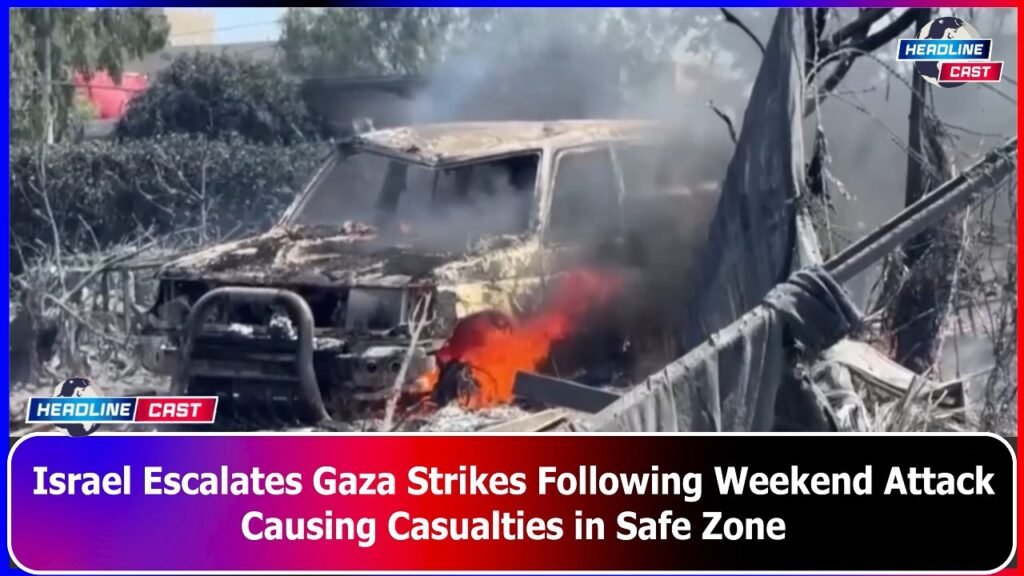
On Monday, Israel launched strikes on the southern and central Gaza Strip to intensify pressure on Hamas. This follows a weekend attack aimed at the militant group’s leadership, which resulted in numerous Palestinian casualties who had taken refuge in a makeshift camp.
The strike on Saturday devastated the crowded area of Mawasi near the Mediterranean coast, leaving behind a scene of destruction with burning vehicles and numerous bodies. Displaced survivors, like 30-year-old market seller Aya Mohammad, expressed their despair and uncertainty about where to seek safety next.
Mawasi, located on the western outskirts of Khan Younis, had been a designated safe zone sheltering hundreds of thousands of Palestinians. Israel stated that the strike targeted Hamas military commander Mohammed Deif, who played a key role in the October 7th assault on Israeli towns. According to the military, the targeted area was a Hamas compound, not a tented camp.
Palestinian officials reported at least 90 deaths and hundreds of injuries from the strike. Journalists on the scene captured the chaos, with residents rescuing the wounded and retrieving bodies amid the smoke and flames.
Further south in Rafah, heavy fighting continued on Monday. Israeli forces demolished several homes, and medical officials reported recovering ten decomposing bodies of Palestinians killed by Israeli fire in the eastern parts of the city. In central Gaza, air and tank shelling intensified in the historic refugee camps of Al-Bureij and Al-Maghazi, with health officials reporting several fatalities from these strikes.
In the central Gaza Strip’s Al-Nuseirat camp, an Israeli air strike on a house resulted in 11 deaths. The Israeli military confirmed targeting dozens of Palestinian military sites across Gaza, claiming the elimination of numerous gunmen, including those in Rafah and central Gaza, often in close combat situations.
The Al-Quds brigade, the armed wing of the Islamic Jihad militant group, reported fierce battles in Rafah’s Yabna camp.
In Deir Al-Balah, the municipality announced it could no longer provide drinking water to the area’s 700,000 residents due to a fuel shortage. In the same area, an Israeli strike earlier on Monday caused multiple casualties within Walid Thabet’s family, as he recounted the harrowing experience of pulling his relatives from the rubble.
Ceasefire talks continued despite the recent violence. A senior Hamas official stated that the group had not abandoned negotiations, although Israel has yet to confirm the fate of Mohammed Deif. U.S. Secretary of State Antony Blinken met with Israeli officials in Washington to discuss bridging differences in ceasefire negotiations. Blinken also raised concerns about civilian casualties in Gaza, emphasizing Israel’s right to target militants while urging efforts to minimize harm to civilians.
The Gaza health ministry reported at least 38,000 Palestinian deaths since the military offensive began on October 7th, with a significant proportion of casualties being civilians. Israel has recorded 326 soldier fatalities and estimates that about a third of Palestinian deaths are fighters. The conflict originated from a Hamas-led attack on Israel, resulting in 1,200 deaths, mostly civilians, and over 250 hostages taken to Gaza.
The UN Environment Programme estimated that clearing the war rubble in Gaza, amounting to around 40 million tons, would take 15 years, cost over $500 million, and require more than 100 trucks. The UN announced plans to bring in more armored vehicles and personal protection equipment for humanitarian aid operations in Gaza, highlighting ongoing challenges in delivering aid due to Israeli inspections and internal lawlessness within the enclave, where the risk of famine remains high.